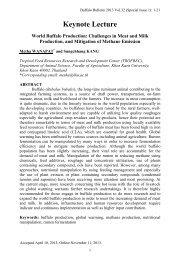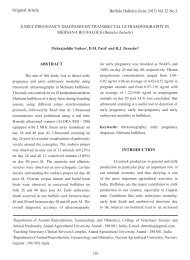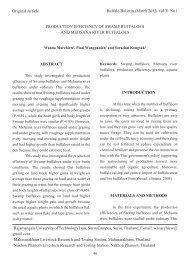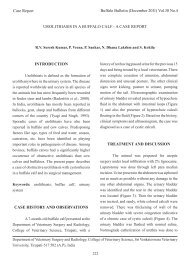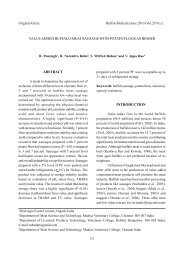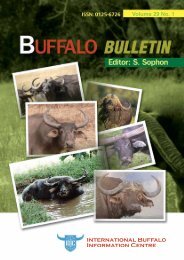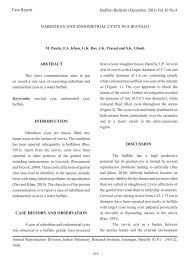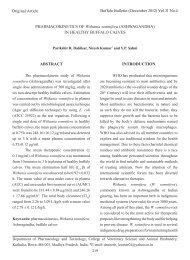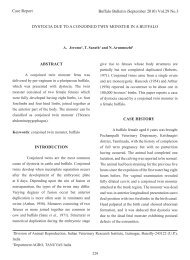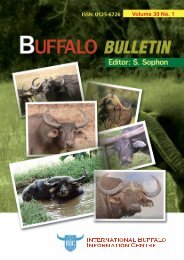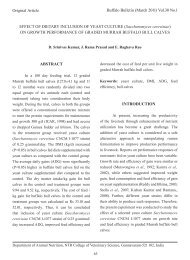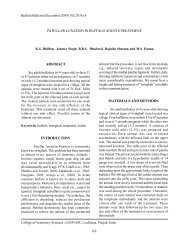Hydroallantois in buffalo: A case report
Hydroallantois in buffalo: A case report
Hydroallantois in buffalo: A case report
You also want an ePaper? Increase the reach of your titles
YUMPU automatically turns print PDFs into web optimized ePapers that Google loves.
Case Report<br />
Buffalo Bullet<strong>in</strong> (June 2012) Vol.31 No.2<br />
HYDROALLANTOIS IN BUFFALO: A CASE REPORT<br />
Sharad Kumar, Utsav Sharma, A.K. Pandey, Sanjay Agrawal, R.B. Kushwaha and A.K. Tripathi<br />
ABSTRACT<br />
A <strong>case</strong> of hydroallantois <strong>in</strong> <strong>buffalo</strong> and<br />
successful treatment is <strong>report</strong>ed.<br />
Keywords: hydroallantois, <strong>buffalo</strong>es, gestational<br />
disorder, pregnancy<br />
INTRODUCTION<br />
<strong>Hydroallantois</strong> is one of the gestational<br />
disorder <strong>in</strong> which sudden <strong>in</strong>crease <strong>in</strong> allantoic fluid<br />
occurs <strong>in</strong> allantoic cavity due to foetal membrane<br />
pathology lead<strong>in</strong>g to bilateral enlargement of<br />
abdomen (Roberts, 1971). This is more common<br />
last phase of third trimester <strong>in</strong> dairy and beef cattle<br />
and less so <strong>in</strong> <strong>buffalo</strong>es and heifers (Sr<strong>in</strong>ivas and<br />
Sreenu, 2006). The present <strong>report</strong> describes a <strong>case</strong><br />
of hydroallantois <strong>in</strong> a 10-year-old <strong>buffalo</strong> that was<br />
7 months pregnant.<br />
CASE HISTORY AND CLINICAL<br />
EXAMINTATION<br />
A 10-year-old <strong>buffalo</strong> that was 7 months<br />
pregnant was presented to the Veter<strong>in</strong>ary Referral<br />
Hospital and Polycl<strong>in</strong>ic, SKUAST-J with the history<br />
of sudden enlargement of abdomen <strong>in</strong> previous 4-5<br />
days (Figure 1) and be<strong>in</strong>g unable to sit on its own.<br />
The <strong>buffalo</strong> was dull and depressed, its eyes ball<br />
were sunken, and its muzzle was dry.<br />
The physiological parameters pulse rate,<br />
respiratory rate and rectal temperature were 105 per<br />
m<strong>in</strong>ute; 30 per m<strong>in</strong>ute and 102.3ºF, respectively.<br />
Ballottement of the abdomen failed any evidence of<br />
foetus. Extensive venous collateral circulation was<br />
noticed <strong>in</strong> the ventrolateral part of the abdomen.<br />
Rectal exam<strong>in</strong>ation revealed highly distended<br />
uterus fill<strong>in</strong>g most of the pelvic cavity. Vag<strong>in</strong>al<br />
exam<strong>in</strong>ation revealed completely dilated cervix and<br />
foetal membrane with fluid com<strong>in</strong>g out <strong>in</strong> vag<strong>in</strong>a.<br />
Based on history, symptoms and observations, the<br />
<strong>case</strong> was diagnosed as hydroallantois.<br />
TREATMENTS AND DUSCUSSION<br />
For removal of allantoic fluid, hand was<br />
<strong>in</strong>serted <strong>in</strong> vag<strong>in</strong>a and protruded part of allantoic<br />
sac was broken out and keep<strong>in</strong>g the hand <strong>in</strong> vag<strong>in</strong>a,<br />
about 60 litres of allantoic fluid was slowly dra<strong>in</strong>ed.<br />
After that separated part of placenta was removed<br />
from vag<strong>in</strong>a manually (Figure 2) and aga<strong>in</strong> 80<br />
litres of allantoic fluid was dra<strong>in</strong>ed out from uterus<br />
slowly. The dra<strong>in</strong>ed allantoic fluid was watery<br />
and amber <strong>in</strong> colour. After complete removal of<br />
allantoic fluid, foetus was palpated and delivered<br />
by rope traction tied <strong>in</strong> h<strong>in</strong>d limbs (Figure 3). The<br />
rema<strong>in</strong><strong>in</strong>g necrosed portion of placenta was removed<br />
manually. The animal was adm<strong>in</strong>istered 10 litres of<br />
Faculty of Veter<strong>in</strong>ary Sciences and Animal Husbandry, R.S. Pura, Jammu, India<br />
67
Buffalo Bullet<strong>in</strong> (June 2012) Vol.31 No.2<br />
each 5% dextrose normal sal<strong>in</strong>e and normal sal<strong>in</strong>e<br />
solution <strong>in</strong>travenously. Injection of oxytetracycl<strong>in</strong>e<br />
1500 mg (Terramyc<strong>in</strong>, Pfizer) and <strong>in</strong>jection of<br />
dexamethasone 60 mg (Dexasone, Zydus Animal<br />
Health Limited) were given <strong>in</strong>travenously whereas<br />
<strong>in</strong>jection of Meloxicam 150 mg (Melonex, Intas<br />
Neovet) was adm<strong>in</strong>istered <strong>in</strong>tramuscularly. Bolus<br />
of Furazolidone and urea (Furea, Pfizer) was placed<br />
<strong>in</strong> uterus. The same treatment was cont<strong>in</strong>ued for<br />
next 3 days except <strong>in</strong>j Dexamethasone. The animal<br />
recovered uneventfully.<br />
In hydroallantois, accumulation of allantoic<br />
fluid is rapid due to placental abnormalities and<br />
possible <strong>in</strong>terference with sodium metabolism at<br />
the cell level (Jackson, 1980). <strong>Hydroallantois</strong> is<br />
seen mostly <strong>in</strong> 8-9 months of pregnancy (Roberts,<br />
1972); however, <strong>in</strong> the present <strong>case</strong> it was seen <strong>in</strong> 7<br />
months of pregnancy and could be due to necrosed<br />
and oedematous placenta. Similar f<strong>in</strong>d<strong>in</strong>gs and<br />
cause also be earlier said by different researchers<br />
(Arthur, 1957, Roberts, 1972; Vandeplassche et al.,<br />
1965). Sudden <strong>in</strong>crease <strong>in</strong> fluid imposed pressure<br />
over diagphragm result<strong>in</strong>g <strong>in</strong> respiratory distress.<br />
The shift<strong>in</strong>g of fluid from <strong>in</strong>terstitial tissue or cell to<br />
cavity might have been responsible for dehydration,<br />
sunken eye, dullness and depression (Arthur<br />
et al., 1989). Due to heavy bilateral distension<br />
of abdomen, ballotment was failed to revealed<br />
Figure 1. A 10-year-old <strong>buffalo</strong> with hydroallantois.<br />
Note the distension of abdomen.<br />
Figure 2. Heavy, necrosed and edematous foetal<br />
membrane after removal.<br />
Figure 3. Dead foetus after removal. Note the non-hairy sk<strong>in</strong>.<br />
68
Buffalo Bullet<strong>in</strong> (June 2012) Vol.31 No.2<br />
presence of foetus. Dra<strong>in</strong>age of allantoic fulid or<br />
cesearean is the only treatment option (Arthur et<br />
al., 1989). In present <strong>case</strong>s, foetus was removed<br />
after dra<strong>in</strong>age of allantoic fluid per vag<strong>in</strong>um as the<br />
cervix was dilated at the time of exam<strong>in</strong>ation and<br />
placenta and foetus was with<strong>in</strong> the reach of hand.<br />
Inj. Dexona was adm<strong>in</strong>istered to prevent the shock<br />
due to rapid dra<strong>in</strong>age of fluid. Rema<strong>in</strong><strong>in</strong>g treatment<br />
was given symptomatically. The present paper<br />
described and discussed a <strong>case</strong> of hydroallantois<br />
and its successful management <strong>in</strong> cattle.<br />
REFERENCES<br />
Arthur, G.H., D.E. Noakes and H. Pearson. 1989.<br />
Veter<strong>in</strong>ary Reproduction and Obstetrics,<br />
ELBS, 118-120.<br />
Arthur, G.H. 1957. Some notes on the quantities<br />
of fetal fluids <strong>in</strong> rum<strong>in</strong>ants with special<br />
reference to Hydrops Amnii. Brit. Vet. J.,<br />
113: 17.<br />
Jackson, P.G.G. 1980. Handbook of Veter<strong>in</strong>ary<br />
Obstretics. W.B. Saunders Company<br />
Limited, London. 221p.<br />
Roberts, J.S. 1971. Veter<strong>in</strong>ary Obstetrics and<br />
Genital Diseases (Theiogenology), CBS<br />
Publishers and Distributors. 776p.<br />
Sr<strong>in</strong>ivas, M. and Makkena Sreenu. 2006.<br />
<strong>Hydroallantois</strong> with foetal ascites <strong>in</strong> a<br />
<strong>buffalo</strong>. Indian Vet. J., 83(12): 1342-1343.<br />
Vandeplassche, M., W. Oyaert, R. Bouters, C.<br />
Vandenhende, J. Sp<strong>in</strong>cemsille and J.<br />
Hermam. 1965. Uber die Eihautwassersucht<br />
beim R<strong>in</strong>d, Wiener Tierarztl. Monatsschr.,<br />
5(52): 461.<br />
69



